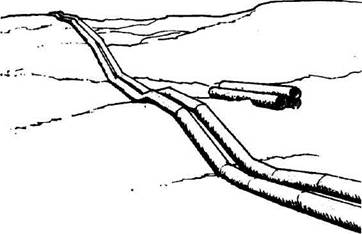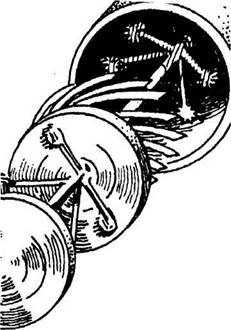How it Works Now
Now let's follow the travels of a tank of crude oil brought out of our typical well, Pioneer Smith Number One. From the Christmas tree at the wellhead it goes - by gravity if possible, otherwise by pump -to one of a number of tanks on the oil field, called lease tanks. From there it flows through a small pipeline to the nearest large trunk pipeline. A gauger on each lease tank measures the amount of oil flowing into the pipeline and records the number of gallons taken out. The large trunk pipelines carry the oil direct to a refinery or to a shipping point for transfering it to a tank truck, a tanker, tank car, or barge. Then it will be shipped to a more distant refinery. The first successful oil pipeline, four miles long, was laid by Samuel van Syckle near Oil Creek, Pennsylvania, in 1865, but the first important one wasn't finished until 1879. It ran from western Pennsylvania over the Allegheny Mountains to Williamport in the central part of the state. This line was 110 miles long and was the first of a maze of pipelines which soon spread all over the country. Over mountain ranges and through deserts and swamps run these huge steel pipes, thirty inches or more in diameter. The pipelines are run almost like railroad systems, with trunk and branch lines, and tank farms where oil is stored until it is needed. Every sixty miles or so there is a powerful pumping station full of control panels, valves, and red and green signal lights. These con-
Pipelines crossing a desert.
trols keep the oil moving through the pipe at two or three miles an hour. The pipelines are constantly inspected for leaks or stoppages. At one time this was done by pipe walkers on foot. Now inspectors use low-flying planes, from which they can spot a leak by the dark patches made by the oozing oil. Pipelines are cleaned by a device called a pig. This mechanism, has metal blades that scrape the inside of the pipe and keeps it clear. The pressure of the oil itself forces the pig to move through the pipe. The pig can only go from one pumping station to the next, where it is taken out and cleaned.
To clear the line of dirt and sludge, or to locate some larger obstruction, a "go-devil" is sent scratching down the inside of the pipe. This is a flexible machine of rollers and steel springs, pushed along by the flow of the oil. It shoves dirt, paraffin, and any loose objects ahead of it as it clatters through the pipe. The go-devil is accompanied on the outside by a man on foot, who can locate it by the slight scrapping noise it makes; if the noise
GASOLINE KEROSENE BENZENE
Tranportation and Storage ceases he knows the go-devil has found something too big for it to handle. Then he calls in men to dig up the pipe and remove the obstruction. 8 Oil becomes less fluid as it grows colder, and so in cold climates 9 Today everybody needs oil. Pipelines reach into the most remote 1Q In the United States, as all over the world, gas from natural-gas wells also flows through pipelines to almost every part of the country. It supplies mills, factories and homes.
|



 Typical distribution of petroleum products in a product pipeline.
Typical distribution of petroleum products in a product pipeline.


